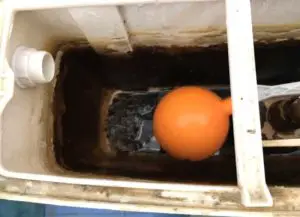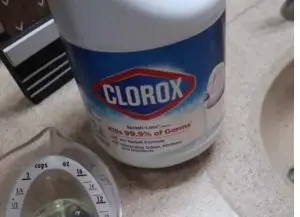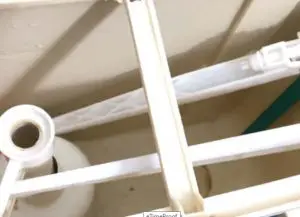Cleaning the bathroom is a must if you want to maintain high levels of hygiene. However, even though homeowners regularly clean the toilet, they usually forget about the toilet tank. Like any other part of the toilet, the toilet tank also requires some cleaning.
If the toilet tank is not attended to for a long period, it will harbor dust, bacteria, mold, and mildew. These may bring about an unpleasant smell and affect the efficiency of the toilet. Toilet tanks need to be cleaned at least twice a year to prevent unpleasant odors from building up and allow the toilet to work very efficiently.
Like any other part of the toilet, tanks can be cleaned with commercial toilet cleaners. But if they are filthy, they should be cleaned using vinegar or bleach. Harsh Chemicals You Must Avoid:
-Hydrochloric acid
-Sodium hypochlorite
-Chlorine bleach
-Cetrimonium chloride
-Sodium hydroxide
-Sodium lauryl ether sulfate
Avoid using toilet cleaner if it contains these toxic chemicals (check on the cleaning product level); otherwise, it may rust the tank and cause different skin problems.
6 Steps: How to Clean a Toilet Tank?
Follow this step-by-step guide on how to clean your toilet tank properly, and you will always have a clean and pleasant-smelling toilet.
Step 1: Tools and materials required
If you desire to have a smooth time cleaning your toilet tank, the first thing to do is gather the right supplies and materials for cleaning. Ensure you have all the cleaning agents, clothes, and protective wear. The things you will require include:
- Rubber gloves
- Scrub brush with a long handle
- Distilled white vinegar
- Disinfectant cleaner
- Sponge
- Natural toilet tank cleaner
When buying cleaning agents, ensure that they are not corrosive to avoid damaging the flapper and other delicate tank components. That’s why we’ve featured distilled white vinegar.
Step 2: Empty the toilet tank

After gathering all the right tools and materials for cleaning, you should empty the toilet tank. You can start to empty the tank by locating the water valve and shutting it off. You will find a wall behind the toilet. Next, open the lid on top of the toilet tank and flush the water. Make sure the water has drained entirely before proceeding. Depending on the size of your toilet’s water, you may need two or three flushes to clear the water of the toilet tank. It is necessary to drain the toilet completely if you have an American Standard toilet in your bathroom.
Step 3: Inspect the condition of the toilet tank

Next, you should check the condition of the toilet tank. Doing this will help you know whether to clean the tank deep or not. If the toilet tank has dirt and grime, you don’t need to clean it deeply. You will only have to scrub the tank and remove the dirt and grime.
However, if the toilet tank has discoloration from mineral deposits and residue at the bottom of the tank, you may have to use a cleaning agent such as baking soda and vinegar. Using vinegar will quickly get rid of mold and mildew in the walls of the toilet tank.
Step 4: Apply a Disinfectant cleaner
Before you start cleaning the tank, put on rubber gloves to protect yourself from dirt and bleach from cleaning agents. Spray the cleaning disinfectant along the walls and at the bottom of the tank. Try not to spray the disinfectant on the metal part inside the toilet tank. If the disinfectant cleaner has bleach in it, the metal parts may end up rusting.

After spraying the tank:
- Enable the cleaner to soak for 10 to 15 minutes.
- Get a scrub brush with a long handle and scrub it inside the tank thoroughly to get rid of dirt and grime on the toilet walls.
- Never use your toilet bowl brush to clean the interior of the tank. You may reintroduce bacteria into the tank.
- Scrub all the corners, sides, and bottom of the tank.
When it comes to the toilet tank’s delicate parts, such as the float ball/cup, refill tube, flapper, or handlebar, use a dampened sponge and a small portion of the cleaner to clean them. These parts are exceptionally delicate, and that’s why you should not spray the disinfectant cleaner directly on them.
Related article: How to fix a leaky toilet problem easily?
If you’re done cleaning, connect the overflow valve, turn the water back, and flush the toilet. Flush many times to get rid of the loose particles in the toilet. If the toilet shows some discoloration and stubborn stains, move on to the next step.
Step 5: Deep clean with distilled white vinegar

Using several cups of vinegar is the best way to clean a filthy toilet. Pour white vinegar into the toilet tank and let it soak. You may need at least three gallons of vinegar, depending on the size of your toilet tank. Allow the vinegar to soak in the tank for at least 12 hours without flushing it. It’s great if you fill the tank with vinegar overnight and clean the tank the next day. But note that you just need to fill the tank with only vinegar and let it sit for 12 hours. Don’t add water to it.
After you have soaked the vinegar in the tank overnight, wear gloves again and flush the vinegar. Repeat step four to get rid of the softened dirt, grime, and discoloration on the toilet tank. Use the same scrub brush with a long handle to clean your toilet tank’s interior. Furthermore, it would help if you used a sponge with some disinfectant cleaner to wipe the tank’s delicate parts. Finally, flush away the grime and dirt and see whether you have a sparkling clean toilet.
Step 6: Check the state of the toilet

While the toilet tank’s lid is still off, inspect your toilet and see whether all the parts are in perfect condition. Do maintenance if needed to increase the efficiency of your toilet. Replace parts like the float ball, a worn-out flapper, or even a defective fill valve.
If everything is fine, close your toilet tank. Nonetheless, you should check on your toilet tank regularly to ensure there are no deposits in it. You should clean it after six months or three months if your bathroom is hectic.
How to keep the toilet tank cleaner for long
- Clean your toilet tank at least two times per year. Some people suggest only cleaning the toilet once a year. But that’s not good enough. And for those with busy toilets, cleaning the tank quarterly isn’t bad either. Also, fix your common toilet issue as soon as possible.
- Consider using tank tablets in the toilet. These may help to keep the toilet tank cleaner for longer. This is because they will keep mold, mildew, and bacteria at a very minimum. Avoid using tablets that are corrosive as they may contain bleach, which may corrode metal parts.
- Remove mineral deposits in the tank regularly. It’s normal for mineral deposits to develop in your tank after a few months of cleaning. Thus, you should check your toilet tank after every two weeks. If you find any mineral deposits, treat the tank with white vinegar.
- If you decide to use tablets to keep the toilet tank clean, start by draining your toilet tank and filling it with vinegar. This should be done regularly to kill mildew and dissolve mineral deposits.
Related article: Follow these easy hacks to unclog a running toilet
How often should I clean the toilet tank?
Some people suggest that you should clean the toilet tank once a year. However, it will be in your best interest to clean the toilet tank at least twice a year. But if you reside in an area with hard water or have a busy bathroom, it’s best to clean the toilet tank quarterly. This will prevent mineral deposits from accumulating in the tank. But if you are a busy person, you can use a tankless toilet that doesn’t need to clean yearly.
Summary
Now that you know when and how to clean your toilet tank, you can be sure your toilet will be as royal a place as it’s supposed to be. You won’t be turned off by a foul smell from the dirty tank or compromise your toilet’s functionality. Use the right toilet cleaner, as a toxic cleaner may corrode your flapper and other parts of the tank. Besides, it would help if you cleaned your toilet tank at least twice every year.
Hi, this is Robert Crossan, the owner of this website, has 17 years of experience in the installation, maintenance, and repair of toilets and plumbing systems. After completing the Level 2 Basic Plumbing course in 2005, I started working in both domestic and commercial buildings as a professional plumber. So I can figure out the core difference between different toilet models and brands. It also helped me monitor their work performance and setbacks.